
The May 1998 riots of Indonesia, also known in Indonesia as the 1998 tragedy or simply the 1998 event, were incidents of mass violence, anti-government demonstrations, and civil unrest in Indonesia in May 1998. The events were mainly in the cities of Medan, Jakarta and Surakarta and also in the province of Central Java.

The 1967 Hong Kong riots were large-scale anti-government riots that occurred in Hong Kong during British colonial rule. Beginning as a minor labour dispute, the demonstrations eventually escalated into protests against the British colonial government. The protests were also partially inspired by riots that had occurred just a few months prior in Portuguese Macau, known as the 12-3 incident, which were ultimately much more successful on the side of the protesters.
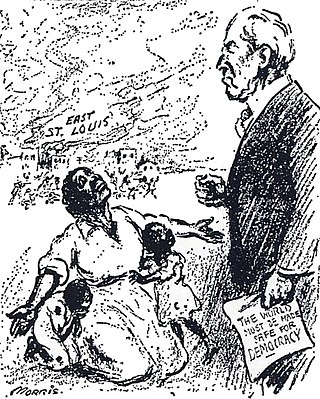
The East St. Louis Riots were a series of outbreaks of labor and race-related violence by White Americans who murdered between 39 and 150 African Americans in late May and early July 1917. Another 6,000 black people were left homeless, and the burning and vandalism cost approximately $400,000 in property damage. The events took place in and near East St. Louis, Illinois, an industrial city on the east bank of the Mississippi River, directly opposite the city of St. Louis, Missouri. The July 1917 episode in particular was marked by white-led violence throughout the city. The multi-day riot has been described as the "worst case of labor-related violence in 20th-century American history", and among the worst racial riots in U.S. history.

Rosarno is a comune (municipality) in the Metropolitan City of Reggio Calabria in the Italian region of Calabria. It is about 70 kilometres (43 mi) southwest of Catanzaro and about 50 kilometres (31 mi) northeast of Reggio Calabria. Rosarno stands on a natural terrace cloaked in olive plantations and vineyards on the left bank of the river Mesima, overlooking the Gioia Tauro plain. The town is an important agricultural and commercial centre known for the production of citrus fruits, olive oil, and wines.
Prior to 1994, immigrants from elsewhere faced discrimination and even violence in South Africa. After majority rule in 1994, contrary to expectations, the incidence of xenophobia increased. Between 2000 and March 2008, at least 67 people died in what were identified as xenophobic attacks. In May 2008, a series of attacks left 62 people dead; although 21 of those killed were South African citizens. The attacks were motivated by xenophobia. In 2015, another nationwide spike in xenophobic attacks against immigrants in general prompted a number of foreign governments to begin repatriating their citizens. A Pew Research poll conducted in 2018 showed that 62% of South Africans viewed immigrants as a burden on society by taking jobs and social benefits and that 61% of South Africans thought that immigrants were more responsible for crime than other groups. Between 2010 and 2017 the immigrant community in South Africa increased from 2 million people to 4 million people. The proportion of South Africa's total population that is foreign born increased from 2.8% in 2005 to 7% in 2019, according to the United Nations International Organization for Migration, in spite of widespread xenophobia in the country. This made South Africa the largest recipient of immigrants on the African continent in 2019.
The July 2009 Ürümqi riots were a series of violent riots over several days that broke out on 5 July 2009 in Ürümqi, the capital city of the Xinjiang Uyghur Autonomous Region (XUAR), in northwestern China. The first day's rioting, which involved at least 1,000 Uyghurs, began as a protest, but escalated into violent attacks that mainly targeted Han people. A total of 197 people died, most of whom were Han people or non-Muslim minorities, with 1,721 others injured and many vehicles and buildings destroyed. Many Uyghurs disappeared during wide-scale police sweeps in the days following the riots; Human Rights Watch (HRW) documented 43 cases and said figures for real disappearances were likely to be much higher.
The Shaoguan incident was a civil disturbance which took place overnight on 25/26 June 2009 in Guangdong, China. A violent dispute erupted between migrant Uyghurs and Han Chinese workers at a toy factory in Shaoguan as a result of false allegations of the sexual assault of a Han Chinese woman. Groups of Han Chinese set upon Uyghur co-workers, leading to at least two Uyghurs being violently killed by angry Han Chinese men, and some 118 people injured, most of them Uyghurs.
Various examples of violence have been attributed to racial factors during the recorded history of Australia since white settlement, and a level of intertribal rivalry and violence among Indigenous Australians pre-dates the arrival of white settlers from the Kingdom of Great Britain in 1788.
The Tarakan riot was an ethnic riot which occurred between September 27 and September 29, 2010 in the city of Tarakan, North Kalimantan, Indonesia. The riot pitched native Tidung people against Bugis migrants. It was triggered by the death of a Tidung elder in a scuffle with a youth gang. During the ensuing riot four people were killed and thousands of civilians were displaced, before a peace agreement was made between the communities.
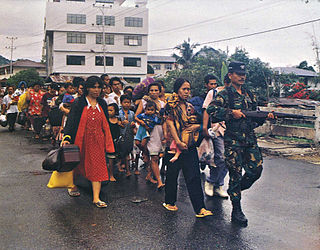
The Maluku Islands sectarian conflict was a period of ethno-political conflict along religious lines, which spanned the Indonesian islands that compose the Maluku archipelago, with particularly serious disturbances in Ambon and Halmahera islands. The duration of the conflict is generally dated from the start of the Reformasi era in early 1999 to the signing of the Malino II Accord on 13 February 2002.
The 2011 Chaozhou riot began on the night of Duanwu Festival June 6, 2011 in Guxiang (古巷镇) Chao'an County, Chaozhou, Guangdong, People's Republic of China.
The 2011 Zengcheng riot (6•11事件) began on June 10, 2011, in Xintang town (新塘镇), Zengcheng, Guangdong, China and is ongoing. The demonstrators are mainly migrant workers in Xintang.
In spite of restrictions on freedom of association, particularly in the decades since the death of Mao Zedong in 1976, there have been incidents of protest and dissent in China. Among the most notable of these were the 1959 Tibetan uprising against Chinese Communist Party (CCP) rule, the 1989 Tiananmen Square protests, which were put down with brutal military force, the 25 April 1999 demonstration by 10,000 Falun Gong practitioners at Zhongnanhai, and the 2022 protests against COVID-19 lockdowns. Protesters and dissidents in China espouse a wide variety of grievances, including corruption, forced evictions, unpaid wages, human rights abuses, environmental degradation, ethnic protests, petitioning for religious freedom and civil liberties, protests against one-party rule, as well as nationalist protests against foreign countries.
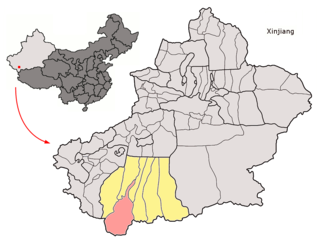
The 2011 Hotan attack was a bomb-and-knife attack that occurred in Hotan, Xinjiang, China on July 18, 2011. According to witnesses, the assailants were a group of 18 young Uyghur men who opposed the local government's campaign against the burqa, which had grown popular among older Hotan women in 2009 but were also used in a series of violent crimes. The men occupied a police station on Nuerbage Street at noon, killing two security guards with knives and bombs and taking eight hostages. The attackers then yelled religious slogans, including ones associated with Jihadism, as they replaced the Chinese flag on top of a police station with another flag, the identity of which is disputed.
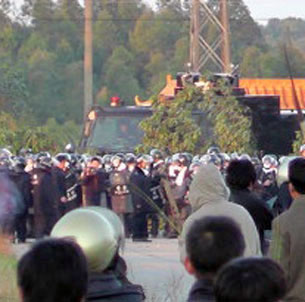
The Wukan protests, also known as the siege of Wukan, was an anti-corruption protest that began in September 2011, and escalated in December 2011 with the expulsion of officials by villagers, the siege of the town by police, and subsequent détente in the village of Wukan, in the east of Guangdong province. The villagers rose up again in June 2016, but were again suppressed. The most recent rounds of clashes were in September 2016, when the former village leader Lin Zulian was sentenced to jail. The clashes were suppressed.
The 2011 Zhongshan riot occurred on November 12, 2011 in Zhongshan, Guangdong, People's Republic of China.
The 2012 Rakhine State riots were a series of conflicts primarily between ethnic Rakhine Buddhists and Rohingya Muslims in northern Rakhine State, Myanmar, though by October Muslims of all ethnicities had begun to be targeted. The riots started came after weeks of sectarian disputes including a gang rape and murder of a Rakhine woman by Rohingya Muslims. On 8 June 2012, Rohingyas started to protest from Friday's prayers in Maungdaw township. More than a dozen residents were killed after police started firing. A state of emergency was declared in Rakhine, allowing the military to participate in administration of the region. As of 22 August 2012, officially there were 88 casualties: 57 Muslims and 31 Buddhists. An estimated 90,000 people were displaced by the violence. Around 2,528 houses were burned; of those, 1,336 belonged to Rohingyas and 1,192 belonged to Rakhines.
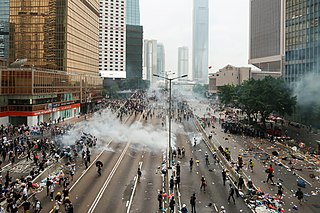
Intense confrontation between anti-extradition bill protesters and the Hong Kong Police Force occurred on 12 June 2019 outside the Government Headquarters in Admiralty, Hong Kong Island. The protest was sparked by the government's introduction of the controversial Fugitive Offenders amendment bill, which was set to go through second reading on 12 June despite mass opposition.







